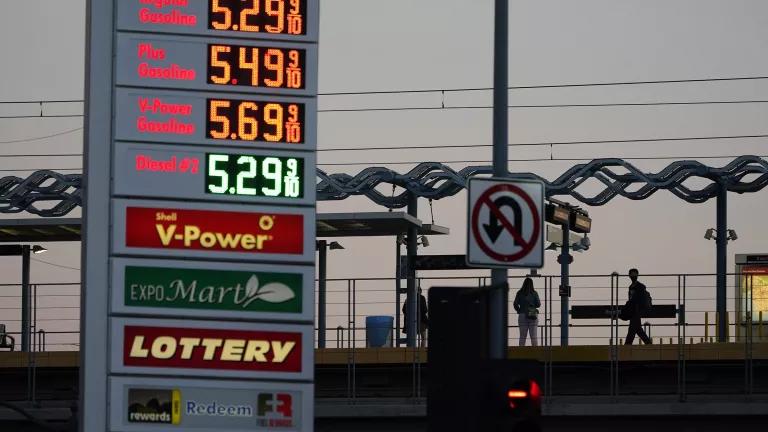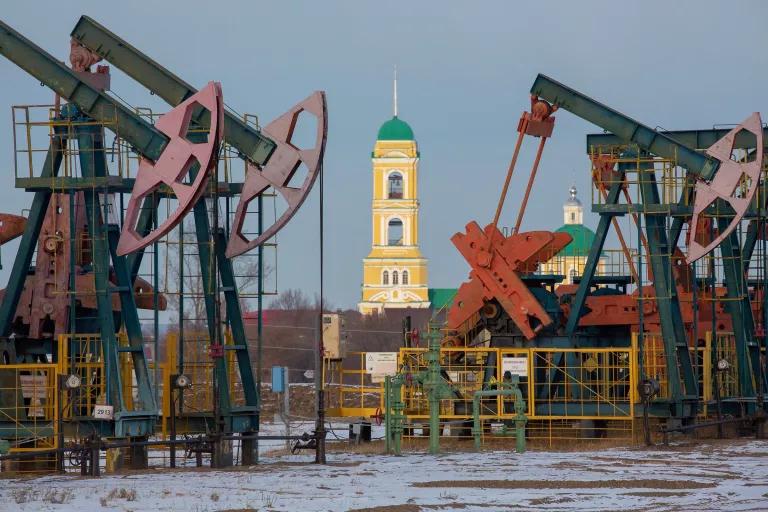The Real Reasons for High Oil and Gas Prices
Dispelling myths is step one. Step two is understanding why clean energy is the only long-term solution to rising gasoline prices.

Gas prices are advertised at more than $5 a gallon on February 28, 2022, in Los Angeles.
Anthony Behar/Sipa USA via AP Photo
In the wake of the devastating Russian invasion of Ukraine, U.S. gas prices soared, averaging $4.25 a gallon. Now fossil fuel companies and their political allies have seized the opportunity to suggest that additional fossil fuel investment is the solution. Their arguments are rife with misinformation. This is calculated, of course, meant to pad the industry’s pockets and lock more generations into fossil fuel dependence. That would, in turn, further delay the clean energy future necessary to achieve real energy independence. Here are some of the myths to look out for and the facts that refute them.
Myth: Drilling for more oil in the United States would lower high gas prices.
Fact-check: Drilling for more oil in the United States will not lower gas prices because the production of U.S. oil does not set the price of gas—the global price of oil does. Oil and gas are global commodities, subject to the whims of notoriously volatile global markets. Their prices are particularly sensitive to geopolitical events and investor sentiment. So everything from war to pandemics to elections can and regularly do cause rapid price swings. That’s why, even though Russian oil made up less than 2 percent of the U.S. supply, ending Russian oil imports still hit U.S. consumers hard. In other words, this is not simply about balancing supply and demand.
In fact, in this case, sky-high gas prices came from a confluence of events. As COVID-19 restrictions eased and economies rebounded rapidly, demand for oil spiked. Pandemic-related supply chain disruptions exacerbated the situation, causing gas prices to go up. Then, more recently and perhaps most saliently, Russia.
Oil markets were roiled when Russia, a petro-state whose exports supply 8 percent of the global oil supply, used its fossil fuel earnings to finance another unjust war. The response by the oil and gas industry was to perpetuate the lie that more drilling would ease the impact on the United States. Of course, they didn’t note that ending our dependence on oil is the clearest way to distance ourselves from the volatility of global oil markets. (Should European allies decide to ban Russian oil, we’ll see another wild swing in prices.) And they ignored the ugly reality that this very dependence on oil and gas has routinely contributed to sowing political chaos and bloodshed like what we’re seeing in Ukraine.

Oil pumpjacks in an oil field near Neftekamsk, Russia
Andrey Rudakov/Bloomberg via Getty Images
Myth: Gas prices are rising because Biden banned oil drilling.
Fact-check: President Biden did not ban oil drilling. In fact, his administration issued more than 3,500 new permits to drill on federal lands in its first year. That’s 34 percent more than the Trump administration did in its first year.
Representatives for the oil and gas industry still exploited the crisis in Ukraine to call for drilling expansion and suggested this would address current gas price issues. The truth is that even if the United States handed out additional oil drilling permits and every oil company went to town, that wouldn’t offer any immediate relief to consumers. On average, it takes more than 10 years from the time a federal drilling lease is issued until it’s producing salable quantities of oil or gas.
What U.S. oil companies and their allies did not suggest was an increase in their current output, which remains at pre-COVID levels. That’s because internally, many of these companies have already said their production is likely to remain flat for reasons that include prioritizing shareholders. Basically, high prices are good for the bottom line.
One step that Biden did take as part of a flurry of climate actions upon taking office last January was to temporarily pause new oil and gas leasing on federal lands and waters in order to review the Trump-era leasing program. But that decision was thrown out by a federal judge last June and had no impact on current gasoline prices.
Myth: The cancellation of the Keystone XL pipeline caused high gas prices.
Fact-check: We can safely say the Biden administration’s decision to cancel the permit for the Keystone XL pipeline (KXL), an extension of the fully operational Keystone Pipeline System, had no impact on current oil prices.
Yes, allies of the oil and gas industry—from Fox News hosts to former vice president Mike Pence—are claiming that the pipeline would have buffered Americans from high gas prices and reduced U.S. reliance on Russian oil. That’s false on multiple levels.
First, it would have taken years for KXL to be fully operational, so its increased supply would have no bearing on current gas prices. Second, the 830,000 barrels of tar sands oil it would have carried daily were intended to head directly to refineries on the Gulf Coast—and then likely to markets overseas.
Myth: Increasing oil and gas production will help secure U.S. energy independence.
Fact-check: Again, oil and gas are global commodities, and there is no way for the United States to wall itself off from swings in global price and supply. As long as we rely on fossil fuels, violent petro-states like Russia will use fossil fuel production as political and financial leverage. Consumers, many of whom were already struggling because of the pandemic, will face continued pain at the pump.
So if you thought that more production would result in energy independence and that meant gas prices would go down, you would be very disappointed.
The only way to permanently protect ourselves from the volatility of the global oil market—and soaring gas prices—is to opt out entirely and transition to both clean energy sources and the electric vehicles that run on that clean energy. Steep federal investments that build out renewable energy infrastructure and make EVs the norm will ultimately provide a far more stable energy market for all and help protect the only planet we’ve got.
This NRDC.org story is available for online republication by news media outlets or nonprofits under these conditions: The writer(s) must be credited with a byline; you must note prominently that the story was originally published by NRDC.org and link to the original; the story cannot be edited (beyond simple things such as grammar); you can’t resell the story in any form or grant republishing rights to other outlets; you can’t republish our material wholesale or automatically—you need to select stories individually; you can’t republish the photos or graphics on our site without specific permission; you should drop us a note to let us know when you’ve used one of our stories.


How to Ditch the Biggest Fossil Fuel Offenders in Your Life
What Are the Solutions to Climate Change?
Meet the Federal Energy Regulatory Commission